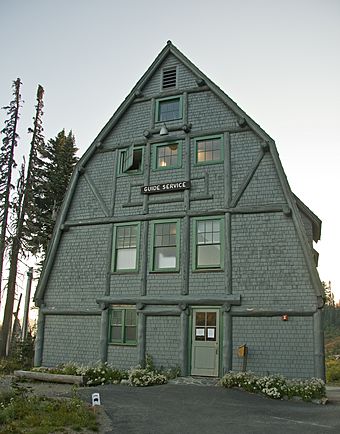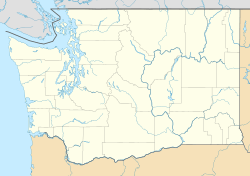Paradise Historic District facts for kids
Quick facts for kids |
|
|
Paradise Historic District
|
|

The guide dormitory at Paradise
|
|
| Location | Mt. Rainier National Park, Paradise, Washington |
|---|---|
| Area | 10 acres (4.0 ha) |
| Architectural style | Rustic style |
| MPS | Mt. Rainier National Park MPS |
| NRHP reference No. | 91000174 |
| Added to NRHP | March 13, 1991 |
The Paradise Historic District is a special historical area within Mount Rainier National Park in Washington. It's located in a beautiful mountain spot called Paradise. This district is famous for its main building, the Paradise Inn. This hotel was built way back in 1917. It has a unique "rustic" style, meaning it looks natural and fits in with the mountain environment. The Paradise Inn is so important that it's considered a National Historic Landmark. Besides the Inn, five other historic buildings are part of this district. The entire district was added to the National Register of Historic Places on March 13, 1991. It's also part of a larger historic area that covers the whole Mount Rainier National Park, celebrating its special old buildings designed by the National Park Service.
Contents
Exploring the Paradise Area
The Paradise area was once hit by a large forest fire in 1885. This fire left behind many standing trees that looked silver. Most of these trees were Alaska Cedar. A lot of this wood was later used to build structures in the park, especially the Paradise Inn.
Today, one of the biggest draws to Paradise is its amazing wildflower meadows. These beautiful fields are located just above the main buildings. The Rainier National Park Company helped develop this area. They built the Paradise Inn in 1917 and added an annex in 1920. The Guide House was also built in 1920. The National Park Service built three other important buildings here.
In the past, the Paradise area had many small cabins. There were 215 of these cabins, built in 1930. They were served by the Paradise Lodge, built in 1931, and were open all year. In 1942, these cabins were sold to house workers during World War II.
Later, there was a plan to make Paradise a day-use area only. This plan suggested tearing down the historic Inn. But people loved the Inn and fought to save it. Because of public support, the Inn was preserved and renovated. The Paradise Lodge was later burned down on purpose in 1965. This made space for parking for the new Paradise Visitor Center.
Historic Buildings of Paradise
Several unique buildings make up the Paradise Historic District. Each one has its own story and design.
The Paradise Inn
The Paradise Inn was built in 1917. It is a large hotel with a very noticeable roof that has many dormers (windows sticking out). Its style is a special "alpine" version of the National Park Service Rustic design. Inside, the Inn shows off its exposed log structure. The high lobby features furniture made from logs by hand. Fourteen doors open from the lobby, supported by log buttresses. These buttresses follow the roof's slope to the ground, helping to hold up heavy snow. The Inn was designed by Heath, Grove and Bell, architects from Tacoma. It had guest rooms in one wing and suites in another.
Paradise Inn Annex
The Paradise Inn Annex was built in 1920. It stands slightly downhill from the main Inn and runs parallel to its lobby. This timber-frame building is 3+1⁄2-stories tall. A multi-story bridge connects it to the main Inn. Seattle architect Harlan Thomas designed it. The building that was finally constructed was smaller than first planned. It was meant to be 300 feet (91 m) long with a stone center. The part that was built was meant to be the south wing. Its construction was simpler, measuring 44 feet (13 m) by 125 feet (38 m).
Guide Service Building
The Guide Service Building is a 3+1⁄2-story timber-frame building. It stands across from the Paradise Inn. The Rainier National Park Company built it in 1920. It has a special gambrel roof design. This building was made to house mountain climbing guides. The basement has a small auditorium and a stage. The ground floor holds offices. The upper levels are dormitory rooms for the guides.
Paradise Ranger Station
The Paradise Ranger Station is a small 1+1⁄2-story building. It has a very steeply pitched roof made of cedar shingles. The ranger station was finished in 1922. It was designed by the National Park Service Landscape Engineering Division. The roof, supported by stone walls, was made to shed the very heavy winter snow. This area gets a lot of snow. A system of cables anchored to the hillside helps the building stand strong against the snow's weight.
Paradise Comfort Station
The Paradise Comfort Station is a public restroom facility. It was built in 1928. The Park Service Western Region Branch of Plans and Designs created its look. Thomas Chalmers Vint supervised its construction. Unlike the ranger station, this building has a very strong, low-pitched roof. This roof is made of reinforced concrete. The walls were covered with stone. The roof was designed to hold up to a 35 feet (11 m) snow load. This means it could handle snow weighing 35 pounds per cubic foot, or 1225 pounds per square foot.
Paradise Ski-Tow Powerhouse
The Paradise Ski-Tow Powerhouse was built to hold a portable ski-tow system. Paradise was a popular place for skiing in the 1930s. However, the Park Service did not allow a permanent ski lift. The ski-tow house was built in 1937 by the Civilian Conservation Corps. It has a steeply pitched roof, much like the ranger station.


